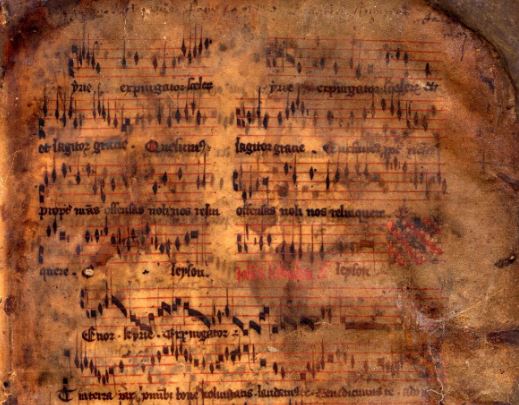[Musealia : Messe de la Sorbonne]
Every month, Sorbonne University invites you to discover an object from its heritage collections. This month, discover the Sorbonne Mass.
The manuscript of the Sorbonne Mass is the oldest and most precious document kept at the Clignancourt Library, dating from the 14th century.
Discovered around 1870 by Father Jean-François-Nicolas Richard, this double sheet of parchment in black notation on red lines served as the cover for a register of the Catholic-civil status of the parish of Dambelin, near Montbéliard (Doubs); it is also sometimes called the "Besançon Mass", or the "Sorbonne Manuscript".
The Sorbonne Polyphonic Mass, although incomplete (two other bifolios are said to have been lost), is considered the earliest example of a unified cyclical mass. This was the era of the Ars Nova (1310-1377), characterised by the use in France of a new system of notation, both melodic and rhythmic.
In 1952, the Mass was rediscovered by Jacques Chailley, the newly appointed director of the Institute of Musicology of the University of Paris, in the library of the Institute, although it is not known how it came to be there. Although the origin of the Mass is associated with the entourage of the court of the popes of Avignon, its uncertain authorship has been the subject of various hypotheses. Jacques Chailley attributes the mass to Johannes Lambuleti, i.e. Jean Lambelet, cantor of the Augustinian abbey of Montbenoît, according to the inscription 'Johes Labuleti' found in the Kyrie. But for the musicologist Leo Schrade, he is more of a copyist than a composer.
The Mass was restored in 1991 by the Bibliothèque nationale de France (National Library of France). In 2012, the collective work La Messe de la Sorbonne (The Mass of the Sorbonne) was published, which reproduces the manuscript and studies it. Thanks to the transcription, restoration and recomposition of the lost parts of the Mass, its recording (La Messe de la Sorbonne, Paris-Sorbonne University Press / Libreria Editrice Vaticana, 2011, with CD of the audio recording) was made possible by students and teachers of the professional Master's degree "Pratique de la musique médiévale" (Medieval Music Practice) of Paris-Sorbonne.
By Édith Faure, Head of the Clignancourt Library (BSU).
Data sheet
- Name : Polyphonic Mass of the Sorbonne, or Mass of the Sorbonne, or Mass of Besançon
- Type of document: handwritten score
- Inventory number : Res Ms 1
- Format : bifolio : music ; 33.5 x 23 cm
- Date : 14th century
- Place of storage : Clignancourt Library, Sorbonne University
- Online consultation : https://patrimoine.sorbonne-universite.fr/idurl/1/3438
Bibliographie
- La messe de la Sorbonne, dir. Frédéric Billiet, Presses de l’Université Paris-Sorbonne et Libreria Editrice Vaticana, 2011
- Manuscripts and Medieval Song : Inscription, Performance, Context. Helen Deeming and Elizabeth Eva Leach, Cambridge University Press, 2015
- “Autour de La Messe de Besançon”, Jacques Chailley, Acta musicologica, 1956 (consultable en ligne, permalien : https://sorbonne-universite.primo.exlibrisgroup.com/permalink/33BSU_INST/91cgt/cdi_crossref_primary_10_2307_931965)
Find here all the articles of Musealia.





